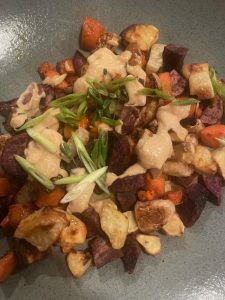
NUNM faculty member Ellen Goldsmith promotes warm foods, healthy digestion for the period between Lunar New Year and the Spring Equinox.
This post was originally published on Ellen Goldsmith’s Pearl Natural Health, and the recipe is from her book Nutritional Healing with Chinese Medicine: + 175 Recipes for Optimal Health.
Even though the Lunar New Year in the Chinese calendar harbors the emerging spring and new beginnings, the Northeast of the United States was recently blanketed with many inches of snow making folks wonder if winter would ever end. (Notice the Buddha’s head popping up from the snow in my friend’s yard!). So, how do we prepare for spring?
In Chinese medicine and nutritional therapy it is vital to our health and well being to harmonize our food, our movement and activity with the energy of the season to support inner balance and health with the external environment. This period between Lunar New Year and the Spring Equinox can be especially tricky with the changeable and chilly weather..
When the emerging spring sends us hints of new life with increased light and shoots of new growth, yet the air is cold, damp and chilly eating foods that warm us to support our kidney and spleen yang ensures its vigor as the seasons change.
In this damp time we need to be careful not to eat foods that are cold or raw, which can require a tremendous amount of digestive fire to break down, metabolize and absorb nourishment. The stomach is the “cooking pot” of our digestion, requiring a balanced internal climate that is neither too hot nor too cold with ample amount of stomach acid (digestive fire) to promote healthy digestion. Healthy digestion is at the center of our health.
Roasted Chunky Root Vegetables with Tangy Tahini Dressing

Roasted vegetables are completely satisfying on days when you want something substantial but simple to prepare . The earthy sweetness of root vegetables is enhanced by the caramelization that occurs when they’re roasted at a high temperature. The tangy dressing offers a nice contrast.
Makes 4 servings
Preheat oven to 400°F (200°C), with racks positioned in upper and lower thirds
Equipment needed: 2 large rimmed baking sheets
1 large turnip, cubed
1 large carrot, cubed
1 tbsp avocado oil, divided
1 Asian sweet potato, peeled and cubed
1 sweet potato (orange Western type), peeled and cubed
Parsley for garnish.
- On 1 of the baking sheets, toss together turnip, carrot and 1 tbsp (15 mL) of the oil.
- On remaining baking sheet, toss together Asian sweet potato, orange sweet potato and remaining oil. Roast in preheated oven, stirring 2 or 3 times, for about 20 minutes or until vegetables are tender. (Turnip and carrot may take slightly longer to cook than sweet potatoes.)
- In a serving bowl, combine turnip, carrot, Asian sweet potato and orange sweet potato. Gently toss with dressing until coated. Sprinkle with parsley.
- Spoon into serving bowls. Serve immediately.
Tangy Tahini Dressing
This nutty, tangy and spicy dressing is also delightful on cooked winter vegetables, braised or steamed greens , or your favorite thin noodles with cooked greens on the side.
3 tbsp. unseasoned rice vinegar
1 Tbsp. toasted sesame oil
1 1/2 tsp. coconut sugar
1 tsp ginger juice – to make the ginger juices, grate ginger and press it through a fine-mes sieve into a bowl. (Or squeeze it with your hands.) Discard solids.
1/2 tsp salt
- In a small bowl, whisk together 1/4 cup water, tahini, rice vinegar, sesame oil, coconut sugar, ginger juice and salt until smooth. You can slowly add water to get the consistency you want.
Health Tip
Nourishing sweet root vegetables support qi, warm the stomach and spleen, and dispel congestion and dampness. The tahini dressing nourishes the blood and supports the kidney. IT is considered a yin tonic, which can also support breast-milk flow in nursing mothers. Sesame seeds are moistening and lubricating to the intestines and helps promote regular bowel movements. Overall this recipe is beneficial to build qi and vitality.
Hope you enjoy this simple, yet delicious recipe to keep you warm during the changing season.
© 2017 All rights reserved: Nutritional Healing with Chinese Medicine: + 175 Recipes for Optimal Health, Ellen Goldsmith, MSOM, L.Ac., Dip.C.H., with Maya Klein, Ph.D.
Ellen Goldsmith
Ellen Goldsmith is a licensed and nationally board certified acupuncturist and Chinese herbalist. She has been in the field of Asian medicine for the past 30 years, teaching, speaking and working with thousands of people to give them the resources, skills and tools they seek to improve the quality of their health and lives. Ellen is the author of the well respected book, Nutritional Healing with Chinese Medicine: + 175 Recipes for Optimal Health. She is on faculty at the National University of Natural Medicine’s College of Classical Chinese Medicine in Portland, Oregon.